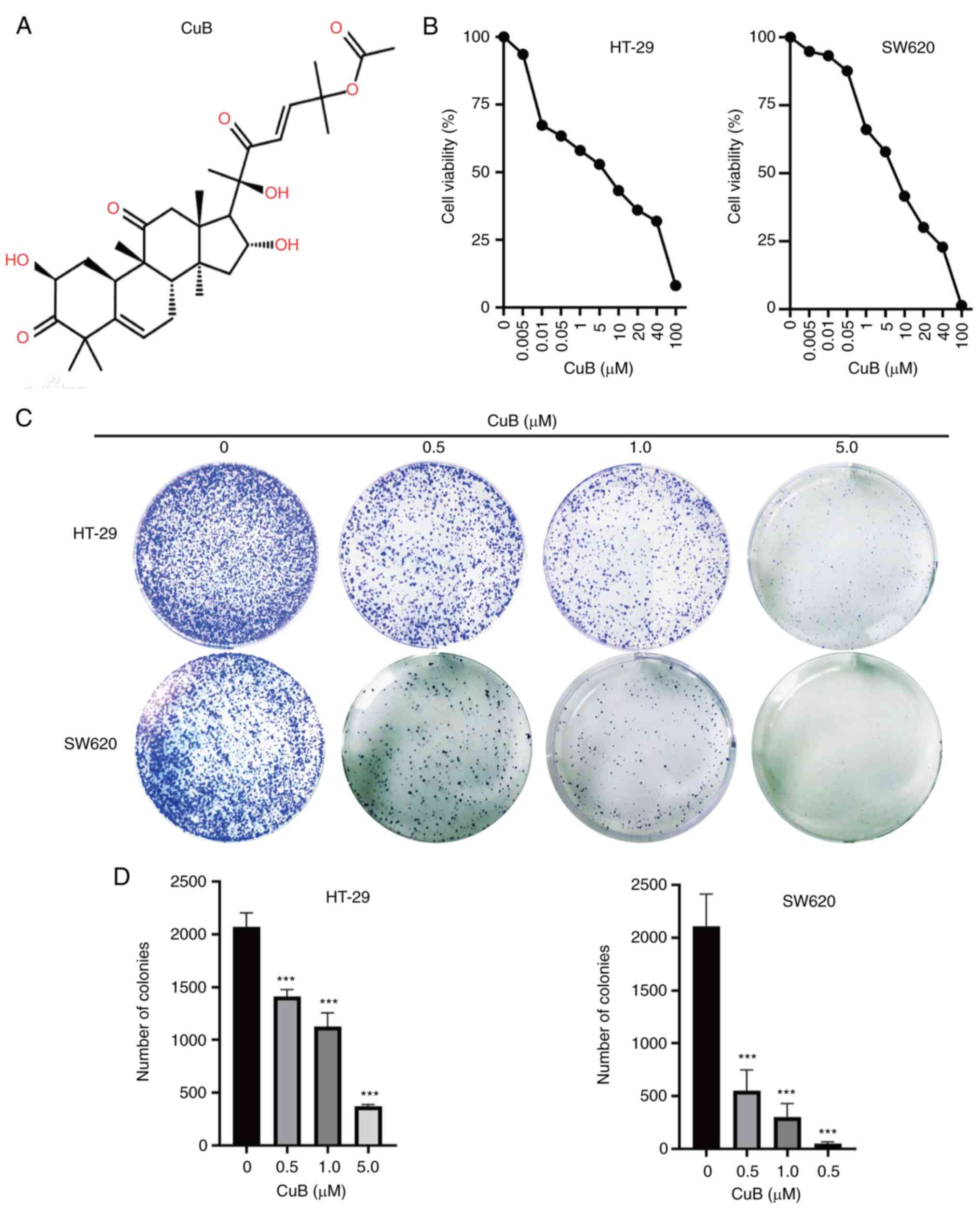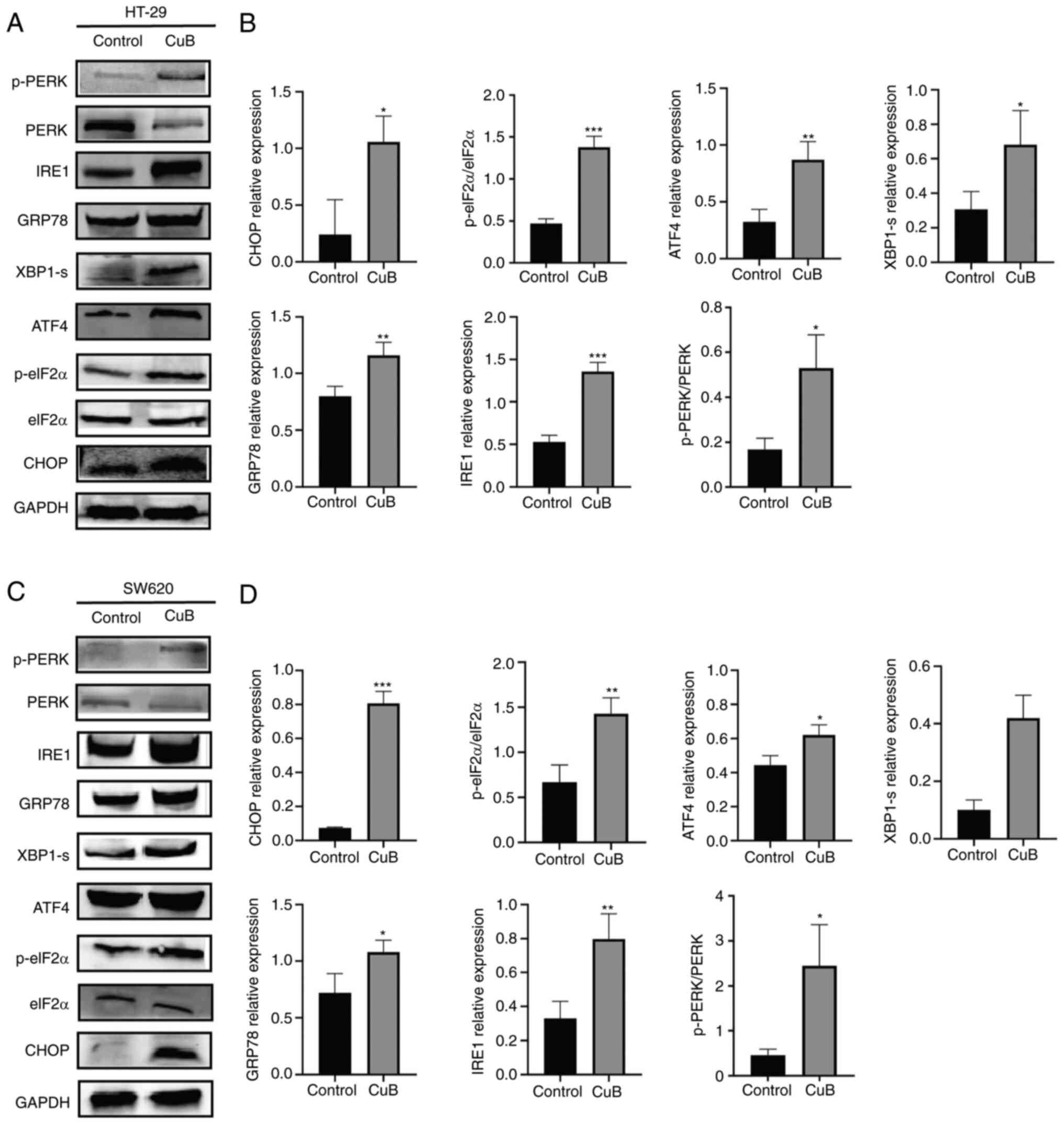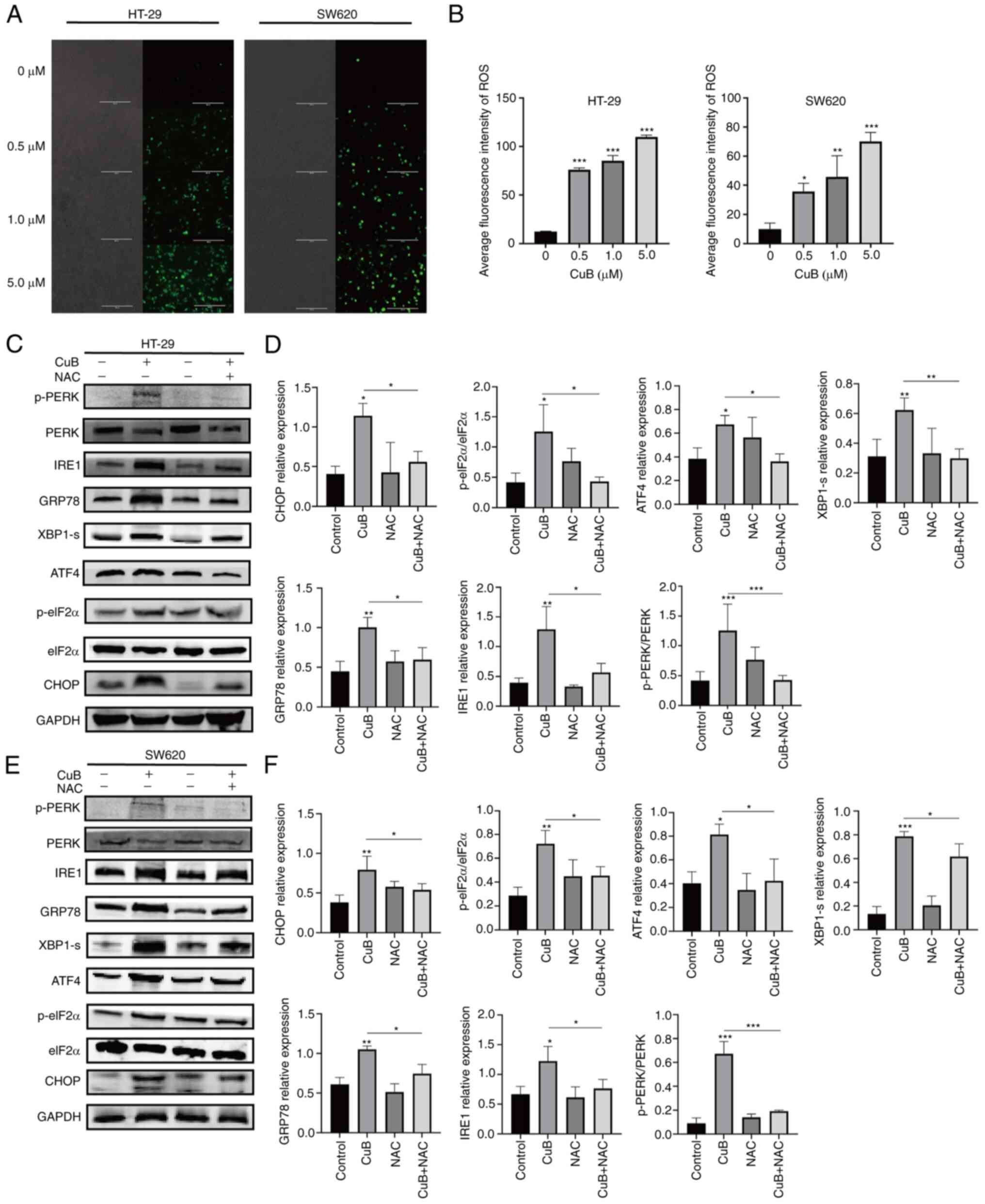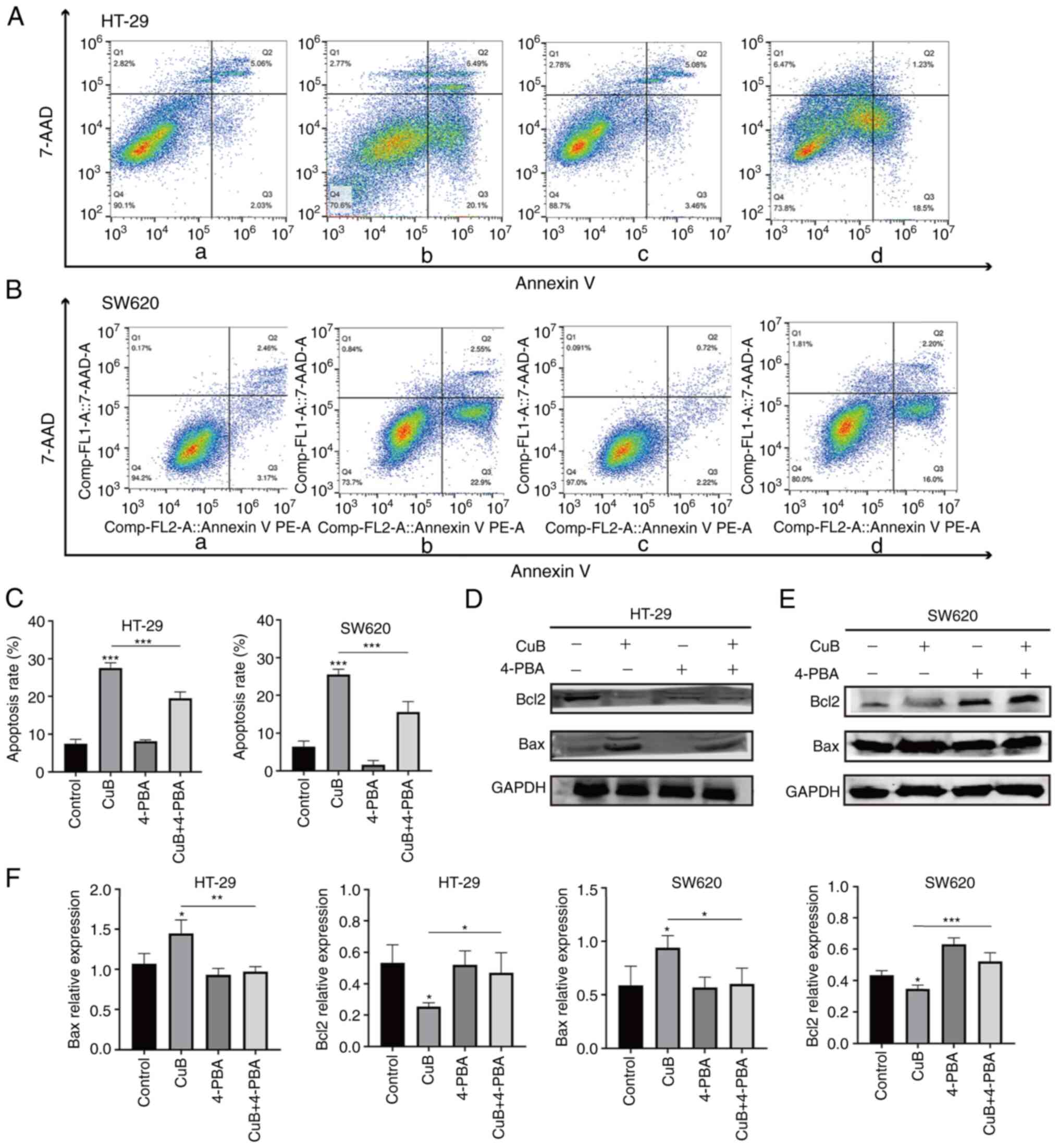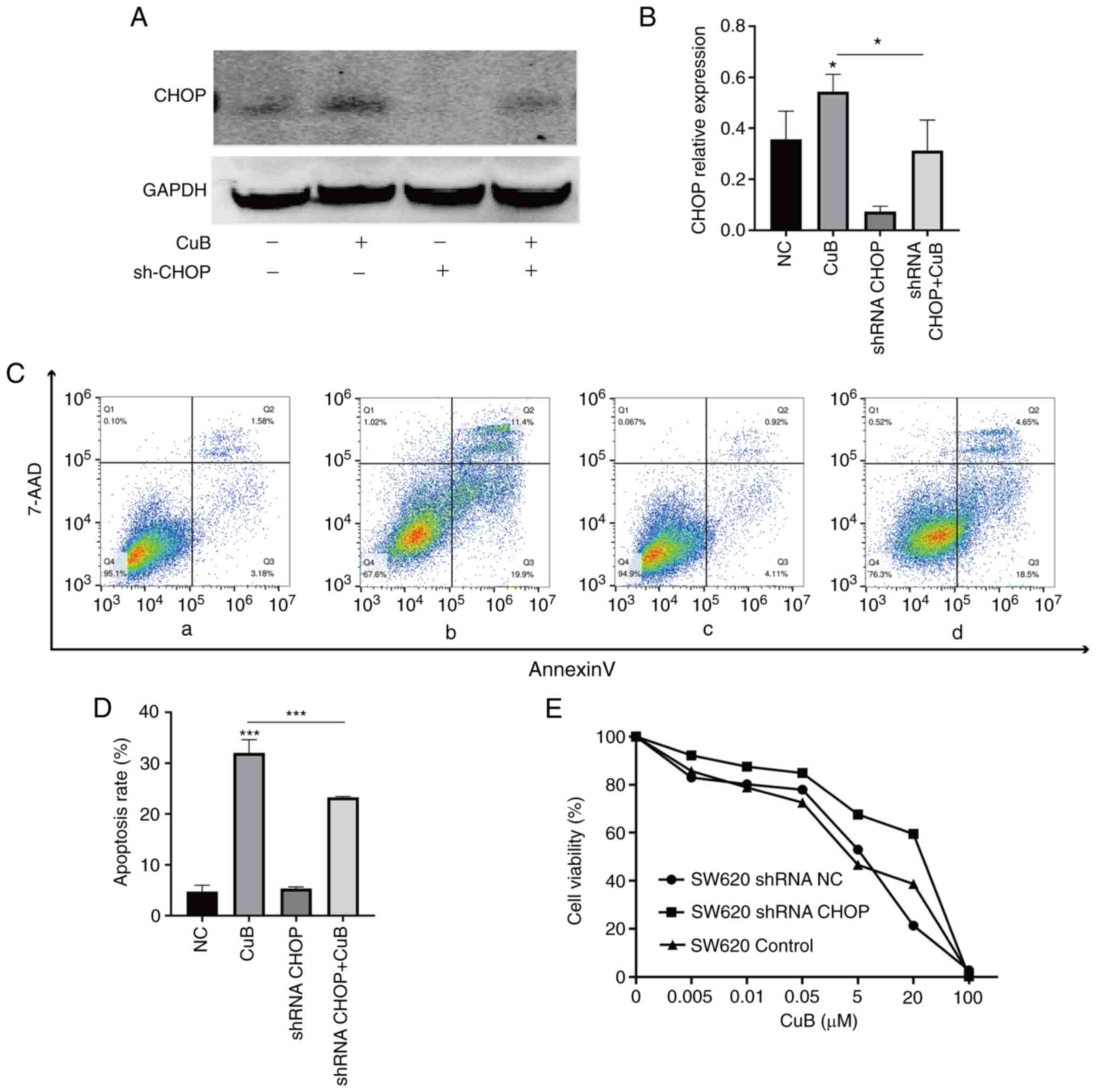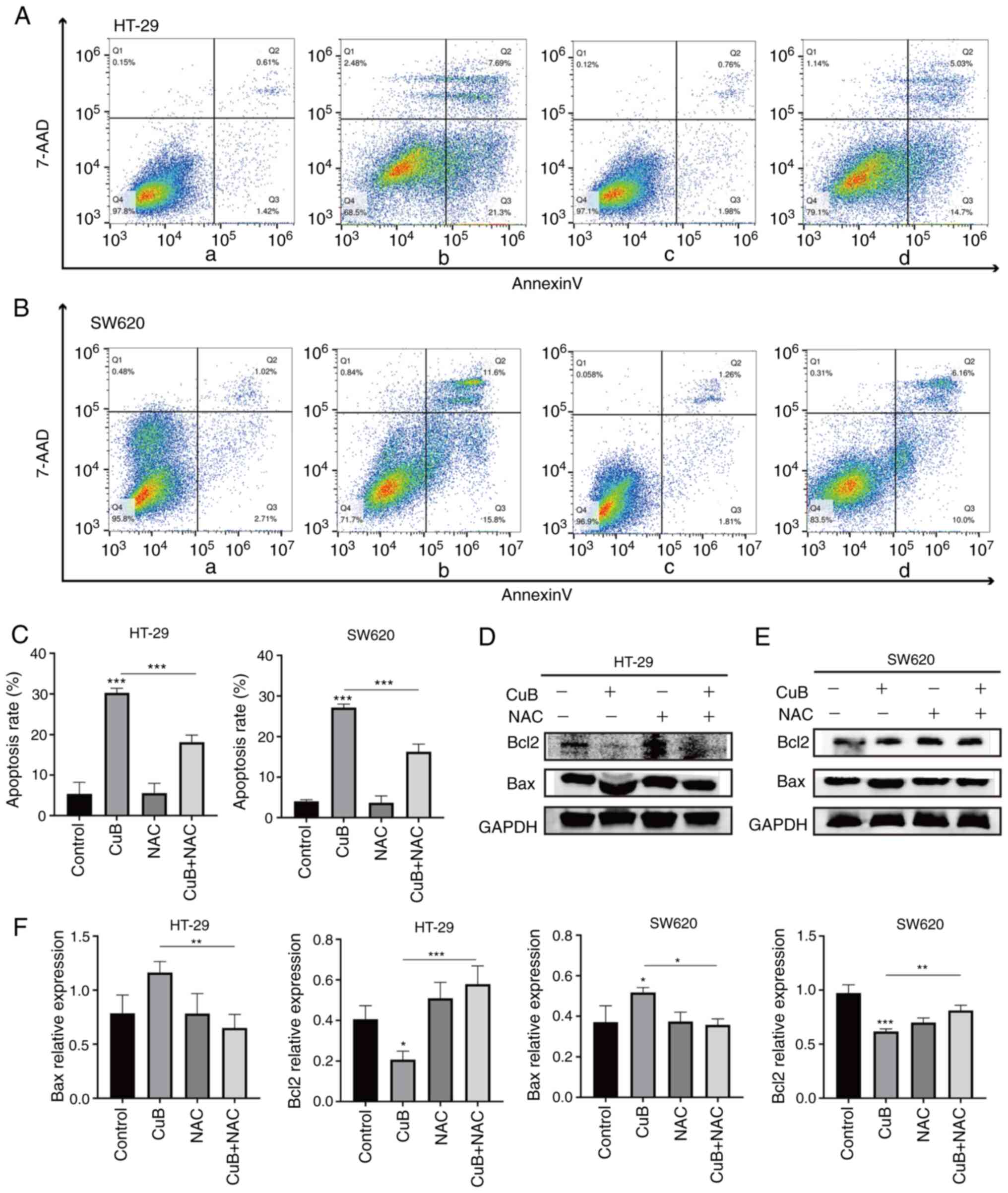|
1
|
Jiang Y, Yuan H, Li Z, Ji X, Shen Q, Tuo
J, Bi J, Li H and Xiang Y: Global pattern and trends of colorectal
cancer survival: A systematic review of population-based
registration data. Cancer Biol Med. 19:175–186. 2021.PubMed/NCBI View Article : Google Scholar
|
|
2
|
Araghi M, Soerjomataram I, Jenkins M,
Brierley J, Morris E, Bray F and Arnold M: Global trends in
colorectal cancer mortality: Projections to the year 2035. Int J
Cancer. 144:2992–3000. 2019.PubMed/NCBI View Article : Google Scholar
|
|
3
|
Han N, Li J and Li X: Natural marine
products: Anti-Colorectal cancer in vitro and in vivo. Mar Drugs.
20(349)2022.PubMed/NCBI View Article : Google Scholar
|
|
4
|
Li QH, Wang YZ, Tu J, Liu CW, Yuan YJ, Lin
R, He WL, Cai SR, He YL and Ye JN: Anti-EGFR therapy in metastatic
colorectal cancer: Mechanisms and potential regimens of drug
resistance. Gastroenterol Rep (Oxf). 8:179–191. 2020.PubMed/NCBI View Article : Google Scholar
|
|
5
|
Kim C and Kim B: Anti-cancer natural
products and their bioactive compounds inducing ER stress-mediated
apoptosis: A review. Nutrients. 10(1021)2018.PubMed/NCBI View Article : Google Scholar
|
|
6
|
Chai Y, Xiang K, Wu Y, Zhang T, Liu Y, Liu
X, Zhen W and Si Y: Cucurbitacin B Inhibits the Hippo-YAP signaling
pathway and exerts anticancer activity in colorectal cancer
cells-pubmed. Med Sci Monit. 19:9251–9258. 2018.PubMed/NCBI View Article : Google Scholar
|
|
7
|
Sinha S, Khan S, Shukla S, Lakra AD, Kumar
S, Das D, Maurya R and Meeran SM: Cucurbitacin B inhibits breast
cancer metastasis and angiogenesis through VEGF-mediated
suppression of FAK/MMP-9 signaling axis. Int J Biochem Cell Biol.
77(Pt A):41–56. 2016.PubMed/NCBI View Article : Google Scholar
|
|
8
|
Liu JH, Li C, Cao L, Zhang CH and Zhang
ZH: Cucurbitacin B regulates lung cancer cell proliferation and
apoptosis via inhibiting the IL-6/STAT3 pathway through the lncRNA
XIST/miR-let-7c axis. Pharm Biol. 60:154–162. 2022.PubMed/NCBI View Article : Google Scholar
|
|
9
|
Liu T, Zhang M, Zhang H, Sun C and Deng Y:
Inhibitory effects of cucurbitacin B on laryngeal squamous cell
carcinoma. Eur Arch Otorhinolaryngol. 265:1225–1232.
2008.PubMed/NCBI View Article : Google Scholar
|
|
10
|
Wakimoto N, Yin D, O'Kelly J, Haritunians
T, Karlan B, Said J, Xing H and Koeffler HP: Cucurbitacin B has a
potent antiproliferative effect on breast cancer cells in vitro and
in vivo. Cancer Sci. 99:1793–1797. 2008.PubMed/NCBI View Article : Google Scholar
|
|
11
|
Dandawate P, Subramaniam D, Panovich P,
Standing D, Krishnamachary B, Kaushik G, Thomas SM, Dhar A, Weir
SJ, Jensen RA and Anant S: Cucurbitacin B and I inhibits colon
cancer growth by targeting the Notch signaling pathway. Sci Rep.
10(1290)2020.PubMed/NCBI View Article : Google Scholar
|
|
12
|
Promkan M, Dakeng S, Suebsakwong P,
Suksamrarn A and Patmasiriwat P: Alterations of cellular
proliferation, apoptosis and autophagy by cucurbitacin B treatment
in colon cancer cells. Ann Oncol. 26 (Suppl 9):S151–S152. 2015.
|
|
13
|
Zhang H, Zhao B, Wei H, Zeng H, Sheng D
and Zhang Y: Cucurbitacin B controls M2 macrophage polarization to
suppresses metastasis via targeting JAK-2/STAT3 signalling pathway
in colorectal cancer. J Ethnopharmacol. 287(114915)2022.PubMed/NCBI View Article : Google Scholar
|
|
14
|
Voeltz GK, Rolls MM and Rapoport TA:
Structural organization of the endoplasmic reticulum. EMBO Rep.
3:944–950. 2002.PubMed/NCBI View Article : Google Scholar
|
|
15
|
Schwarz DS and Blower MD: The endoplasmic
reticulum: Structure, function and response to cellular signaling.
Cell Mol Life Sci. 73:79–94. 2016.PubMed/NCBI View Article : Google Scholar
|
|
16
|
Kim HS, Kim TJ and Yoo YM: Melatonin
combined with endoplasmic reticulum stress induces cell death via
the PI3K/Akt/mTOR pathway in B16F10 melanoma cells. PLoS One.
9(e92627)2014.PubMed/NCBI View Article : Google Scholar
|
|
17
|
Cross CE, Halliwell B, Borish ET, Pryor
WA, Ames BN, Saul RL, McCord JM and Harman D: Oxygen radicals and
human disease. Ann Intern Med. 107:526–545. 1987.PubMed/NCBI View Article : Google Scholar
|
|
18
|
Rhee SG, Woo HA, Kil IS and Bae SH:
Peroxiredoxin functions as a peroxidase and a regulator and sensor
of local peroxides. J Biol Chem. 287:4403–4410. 2012.PubMed/NCBI View Article : Google Scholar
|
|
19
|
Brandes RP, Weissmann N and Schröder K:
Nox family NADPH oxidases: Molecular mechanisms of activation. Free
Radic Biol Med. 76:208–226. 2014.PubMed/NCBI View Article : Google Scholar
|
|
20
|
Li Y, Lu L, Zhang G, Ji G and Xu H: The
role and therapeutic implication of endoplasmic reticulum stress in
inflammatory cancer transformation. Am J Cancer Res. 12:2277–2292.
2022.PubMed/NCBI
|
|
21
|
Zhou Z, Wang Q and Michalak M: Inositol
Requiring Enzyme (IRE), a multiplayer in sensing endoplasmic
reticulum stress. Anim Cells Syst (Seoul). 25:347–357.
2022.PubMed/NCBI View Article : Google Scholar
|
|
22
|
Daverkausen-Fischer L and Pröls F: The
function of the co-chaperone ERdj4 in diverse (patho-)physiological
conditions. Cell Mol Life Sci. 79(9)2021.PubMed/NCBI View Article : Google Scholar
|
|
23
|
Yu SN, Kim SH, Kim KY, Ji JH, Seo YK, Yu
HS and Ahn SC: Salinomycin induces endoplasmic reticulum
stress-mediated autophagy and apoptosis through generation of
reactive oxygen species in human glioma U87MG cells. Oncol Rep.
37:3321–3328. 2017.PubMed/NCBI View Article : Google Scholar
|
|
24
|
Chok KC, Koh RY, Ng MG, Ng PY and Chye SM:
Melatonin induces autophagy via reactive oxygen species-mediated
endoplasmic reticulum stress pathway in colorectal cancer cells.
Molecules. 26(5038)2021.PubMed/NCBI View Article : Google Scholar
|
|
25
|
Perrone GG, Tan SX and Dawes IW: Reactive
oxygen species and yeast apoptosis. Biochim Biophys Acta.
1783:1354–1368. 2008.PubMed/NCBI View Article : Google Scholar
|
|
26
|
Bai L, Ma Y, Wang X, Feng Q, Zhang Z, Wang
S, Zhang H, Lu X, Xu Y, Zhao E and Cui H: Polydatin inhibits cell
viability, migration, and invasion through suppressing the c-Myc
expression in human cervical cancer. Front Cell Dev Biol.
9(587218)2021.PubMed/NCBI View Article : Google Scholar
|
|
27
|
Lee JH, Han SH, Kim YM, Kim SH, Yoo ES,
Woo JS, Jung GH, Jung SH, Kim BS and Jung JY: Shikonin inhibits
proliferation of melanoma cells by MAPK pathway-mediated induction
of apoptosis. Biosci Rep. 41(BSR20203834)2021.PubMed/NCBI View Article : Google Scholar
|
|
28
|
Karagöz GE, Acosta-Alvear D, Nguyen HT,
Lee CP, Chu F and Walter P: An unfolded protein-induced
conformational switch activates mammalian IRE1. Elife.
6(e30700)2017.PubMed/NCBI View Article : Google Scholar
|
|
29
|
Neophytou CM, Trougakos IP, Erin N and
Papageorgis P: Apoptosis deregulation and the development of cancer
multi-drug resistance. Cancers (Basel). 13(4363)2021.PubMed/NCBI View Article : Google Scholar
|
|
30
|
Klungsaeng S, Kukongviriyapan V, Prawan A,
Kongpetch S and Senggunprai L: Cucurbitacin B induces
mitochondrial-mediated apoptosis pathway in cholangiocarcinoma
cells via suppressing focal adhesion kinase signaling. Naunyn
Schmiedebergs Arch Pharmacol. 392:271–278. 2019.PubMed/NCBI View Article : Google Scholar
|
|
31
|
Xia S, Duan W, Liu W, Zhang X and Wang Q:
GRP78 in lung cancer. J Transl Med. 19(118)2021.PubMed/NCBI View Article : Google Scholar
|
|
32
|
Li J, Zhuo JY, Zhou W, Hong JW, Chen RG,
Xie HY, Zhou L, Zheng SS and Jiang DH: Endoplasmic reticulum stress
triggers delanzomib-induced apoptosis in HCC cells through the
PERK/eIF2α/ATF4/CHOP pathway. Am J Transl Res. 12:2875–2889.
2020.PubMed/NCBI
|
|
33
|
Zhou T, Lv X, Guo X, Ruan B, Liu D, Ding
R, Gao Y, Ding J, Dou KF and Chen Y: RACK1 modulates apoptosis
induced by sorafenib in HCC cells by interfering with the IRE1/XBP1
axis. Oncol Rep. 33:3006–3014. 2015.PubMed/NCBI View Article : Google Scholar
|
|
34
|
Redza-Dutordoir M and Averill-Bates DA:
Activation of apoptosis signalling pathways by reactive oxygen
species. Biochim Biophys Acta. 1863:2977–2992. 2016.PubMed/NCBI View Article : Google Scholar
|
|
35
|
Lai KM, Wang JH, Lin SC, Wen Y, Wu CL, Su
JH, Chen CC and Lin CC: Crassolide Induces G2/M cell cycle arrest,
apoptosis, and autophagy in human lung cancer cells via
ROS-Mediated ER stress pathways. Int J Mol Sci.
23(5624)2022.PubMed/NCBI View Article : Google Scholar
|
|
36
|
Niu Y, Sun W, Lu JJ, Ma DL, Leung CH, Pei
L and Chen X: PTEN activation by DNA damage induces protective
autophagy in response to cucurbitacin B in hepatocellular carcinoma
cells. Oxid Med Cell Longev. 2016(4313204)2016.PubMed/NCBI View Article : Google Scholar
|
|
37
|
Li Y, Guo Y, Tang J, Jiang J and Chen Z:
New insights into the roles of CHOP-induced apoptosis in ER stress.
Acta Biochim Biophys Sin (Shanghai). 46:629–640. 2014.PubMed/NCBI View Article : Google Scholar
|
|
38
|
Pytel D, Majsterek I and Diehl JA: Tumor
progression and the different faces of the PERK kinase. Oncogene.
35:1207–1215. 2016.PubMed/NCBI View Article : Google Scholar
|
|
39
|
Tabas I and Ron D: Integrating the
mechanisms of apoptosis induced by endoplasmic reticulum stress.
Nat Cell Biol. 13:184–190. 2011.PubMed/NCBI View Article : Google Scholar
|
|
40
|
Moradzadeh M, Sadeghnia HR, Mousavi SH,
Mahmoodi M and Hosseini A: Ferula gummosa gum induces apoptosis via
ROS mechanism in human leukemic cells. Cell Mol Biol
(Noisy-le-grand). 63:17–22. 2017.PubMed/NCBI View Article : Google Scholar
|















